
(Photo: courtesy of Cathy Mardell, Port Macquarie, New South Wales)
|
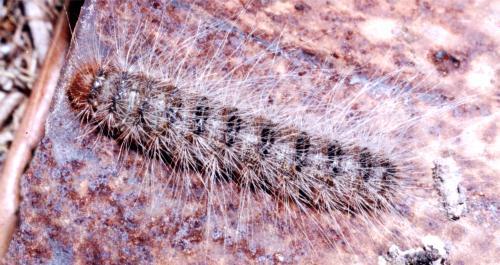
(Photo: Don Herbison-Evans, Manly, New South Wales)
These Caterpillars are grey and hairy with a brown head.
They are famous for walking in processions.
Each Caterpillar when it walks,
leaves a thread of silk from its
spinneret
near its mouth.
Feeding nocturnally, if they nest at the foot of their food tree,
they leave such silk trails each evening as they climb the tree,
and each dawn as they descend again to their nest.
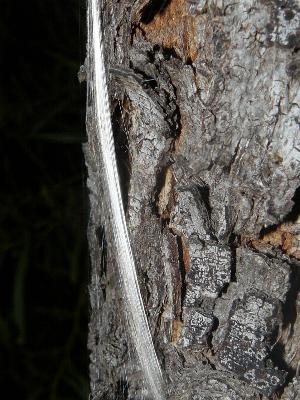
silk 'rope' of threads laid by the train of caterpillars
ascending and descending the trunk every night
(Photo: courtesy of Judy Ormond and Lyn Loger,
Nathalia Wildflower Group Inc, Victoria)
If they totally defoliate their food tree,
the caterpillars go walkabout to locate another one,
again leaving a silken trail.
When mature, the caterpillars go walkabout to find somewhere to pupate,
again leaving a silk trail as they walk.
When a caterpillar of this species encounters such a
silken trail, its nature is to follow it,
particularly if there is a pheromone scent associated with the silk.
Also, the caterpillars are inclined to stay in head-to-tail contact
with each other by contact with the tail hairs of the
caterpillar in front.
Thus the caterpillars when they walk are inclined to
follow each other,
nose to tail, like a minature freight train.
Cathy Mardell of Port Macquarie reported counting
203 in one such procession.
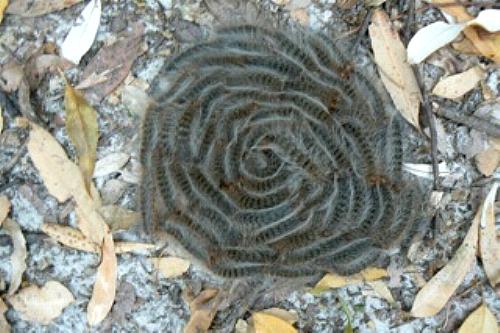
(Photo: courtesy of Don Brown, Lake Cathie, New South Wales)
|
If two caterpillars each locate the silk trail left by the other,
the pair will follow each other, and so will walk around in a circle.
If a whole group do this, then they can end up in a
circular mess, such as found by Don Brown.
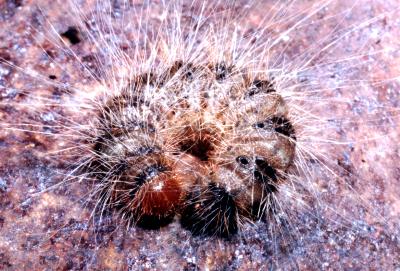
(Photo: Don Herbison-Evans, Manly, New South Wales)
When disturbed, a caterpillar is inclined to curl up
defensively into a tight hairy spiral.
The caterpillars feed on a variety of
Australian native trees and shrubs, including the
Wattles
(MIMOSACEAE) :
Raspberry Jam Wattle ( Acacia acuminata ),
Hickory Wattle ( Acacia aulacocarpa ),
Black Wattle ( Acacia concurrens ),
Hickory Wattle ( Acacia implexa ), and
Sydney Wattle ( Acacia longifolia ),
as well as
Punty Bush ( Senna zygophylla,
CAESALPINIACEAE ),
White Box ( Eucalyptus albens,
MYRTACEAE ),
Beefwood ( Grevillea striata,
PROTEACEAE ), and
Red Maple ( Acer rubrum,
SAPINDACEAE ).
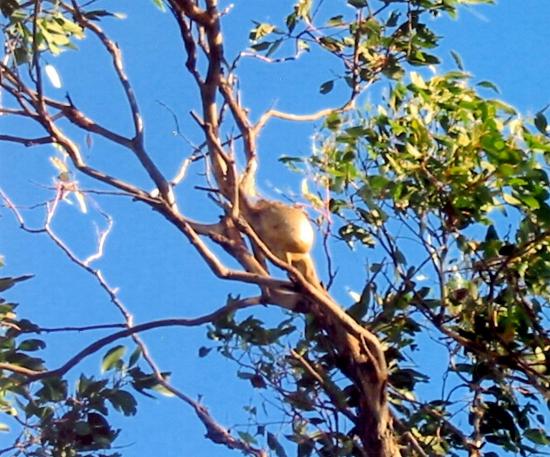
nest high in a Gum tree
(Photo: courtesy of Deborah Keogh, Scone, New South Wales)
During the daytime, the caterpillars hide communally in a nest,
a shelter of silk, frass, old skins, and other debris.
Sometimes this is located on a shoot at the end of a branch,
or sometimes high on the trunk.
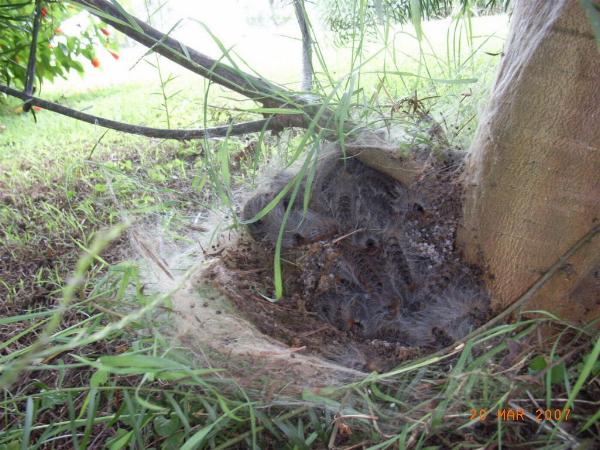
nest at base of a food plant, opened to show the caterpillars inside
(Photo: courtesy of Andrew Sharrock,
Maclean, New South Wales)
Sometimes the nest is located on the ground at the base of the foodplant.
The different nesting habits are evidence that there may be
two or more species currently being included under this name.
The hairs from old skins in such a nest can get blown around and spread
over adjacent vegetation, which is of concern for humans and animals
in the area.
Their hairs are thought to cause skin rash
( urticaria
) in sensitive people, although it has been asserted that it
is the hairs on the dead larval skins and adult moths that cause
these problems.
The rash can last for months after the exposure,
and easily become infected.
Remedies suggested for easing the problem are
vinegar,
a hot bath, and
cheap skin cream such as "Skin Repair"
The presence of the nests of these caterpillars on properties with
breeding horses has been associated with spontaneous abortions in these horses.
Possibly: the hairs blown on the grass are ingested by the horses.
The hairs can cause abortions in horses,
the hairs penetrating the gut and organs internally so getting to the placenta,
although it is possible that bacteria on the hairs are the actual cause of the problems.
But about 1,000 caterpillar species in Australia have abundant hairs.
Maybe all these can cause abortions in horses.
Or maybe it is not the hairs that are the problem.
The Ochrogaster lunifer caterpillars could be being unfairly blamed
because their presence is obvious from the presence of their nests.
There are many other species of butterflies and moths
that have caterpillars that eat grass covertly: see the foot of
the grass webpage,
where many such species are listed.
Maybe some of these caterpillars contain abortifacient substances,
and are eaten by horses accidentally while grazing.
Maybe the caterpillars of each of these species should be tested for
containing abortifacient substances.
Maybe horse breeding requires paddocks that are shielded
from the incursion of all butterflies and moths.
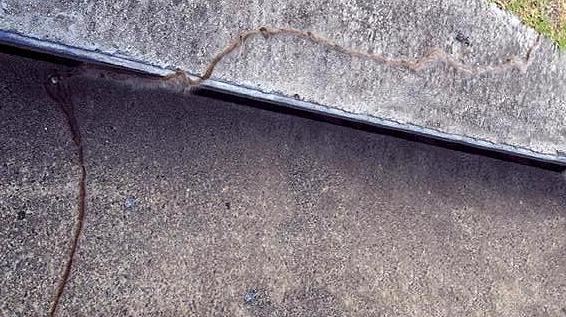
(Photo: courtesy of
Bryce Burrows)
The Ochrogaster lunifer caterpillars grow to a length of about 4 cms.
When they mature, they go on their walkabout to find somewhere
distant from their foodplant to pupate.
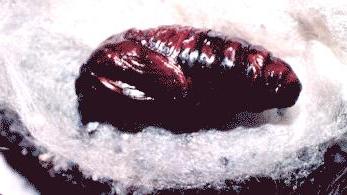
cocoon opened to show the pupa inside
(Photo: courtesy of the
Macleay Collection, Chau Chak Wing Museum, University of Sydney)
The caterpillars each pupate in a silk cocoon in ground debris.
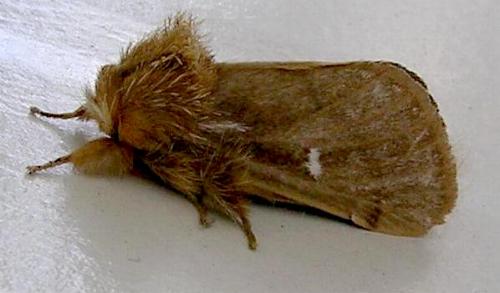
The adult moths have a wingspan of about 4 cms.
They have forewings that are dark grey or brown,
and hindwings that are white shading to grey at the base.
Some have a pale dot in the centre of each forewing.
The moths have a yellow banded abdomen which ends in a
white tuft of hairs.
These and the hairs on their feet can cause Urticaria.
It is unwise to handle the moths directly.
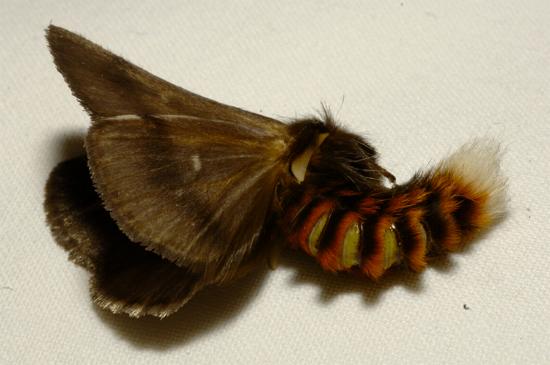
acting dead: display posture
(Photo: courtesy of John Moore, Ravenshoe, Queensland)
When disturbed, the moths are inclined to lie still on one side
with a curled abdomen, so appearing dead.
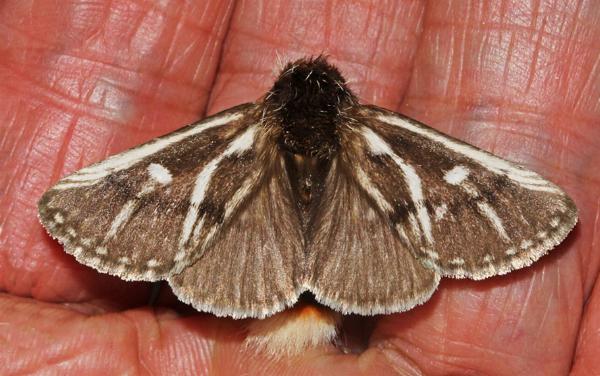
(Photo: courtesy of
Buck Richardson,
Kuranda, Queensland)
Some have white streaks on dark brown forewings,
and some have curved black lines across pale brown forewings.
Again, the variety of colour forms suggests that
there may be more than one species present in Australia.
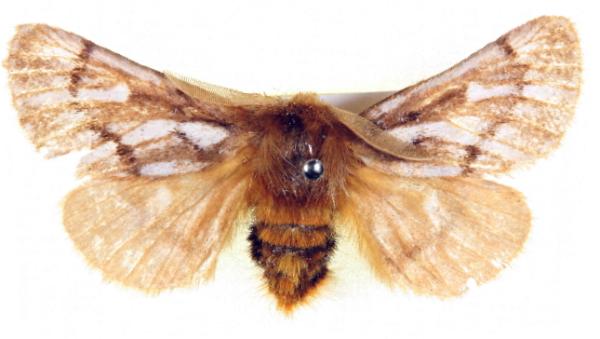
pale brown form
(Photo: courtesy of CSIRO/BIO Photography Group,
Centre for Biodiversity Genomics,
University of Guelph)
Female adult moths lay several hundred eggs,
and lay their eggs in one mass on a food tree.
They cover them with a layer of hairs from their tail.
The female moths have no mouthparts and so die after a few days.
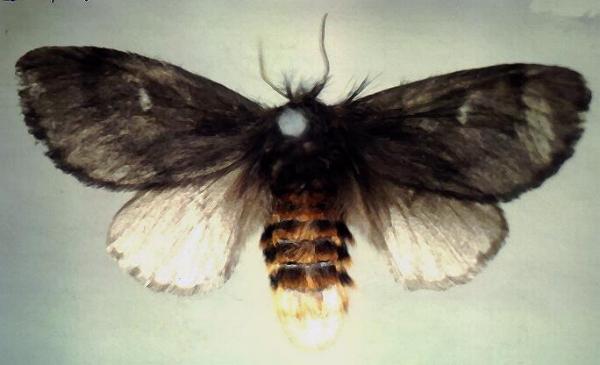
(Specimen: courtesy of the
Macleay Collection, Chau Chak Wing Museum, University of Sydney)
Specimens have been obtained from every mainland state
and territory in Australia, including:
Western Australia,
Northern Territory,
Queensland,
New South Wales,
Victoria, and
South Australia.
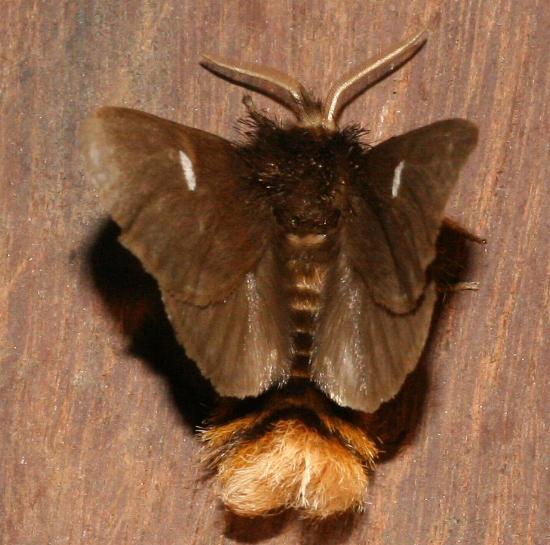
(Photo: courtesy of Jim Foster, taken at Malanda, Queensland)
Further reading :
A. J. Cawdell-Smith, K. H. Todhunter, N. R. Perkins, and W. L. Bryden,
Exposure of mares to processionary caterpillars (Ochrogaster lunifer) in early pregnancy: An additional dimension to equine amnionitis and fetal loss,
Equine Vetinary Journal,
Volume 45, Issue 6 (2013)
Densey Clyne,
The Best of Wildlife in the Suburbs,
Oxford University Press Australia
1993, pp. 133-135.
Graham J. Floater and Myron P. Zalucki,
Habitat structure and egg distributions in the processionary
caterpillar Ochrogaster lunifer: lessons for conservation
and pest management,
Journal of Applied Ecology, Volume 37 (2000), pp. 87-99.
Gottlieb August Wilhelm Herrich-Schäffer,
Sammlung neuer oder wenig bekannter aussereuropäischer Schmetterlinge,
Verzeichniss der in diesem Werke gelieferten Arten nach Reihenfolge ihrer Veroffentlichung,
Series I, Volume 1, Part 7 (1855), pp. 12, 82, and
Plate 66, fig. 377.
Peter B. McQuillan, Jan A. Forrest, David Keane, & Roger Grund,
Caterpillars, moths, and their plants of Southern Australia,
Butterfly Conservation South Australia Inc., Adelaide (2019), pp. 22, 144-145, 177.
Peter Marriott,
Moths of Victoria: part 2,
Tiger Moths and their Allies - Noctuoidea (A),
Entomological Society of Victoria, 2009, pp. 8-11.
Buck Richardson,
Tropical Queensland Wildlife from Dusk to Dawn Science and Art,
LeapFrogOz, Kuranda, 2015, p. 180.
Martin J. Steinbauer,
Thigmotaxis maintains processions of late-instar caterpillars of Ochrogaster lunifer.,
Physiological Entomology,
Volume 34, Issue 4 (December 2009), pp. 345–349.
J.J. Van Schagen, J.D. Majer, and R.J. Hobbs,
Biology of Ochrogaster lunifer Herrich-Schaeffer
(Lepidoptera: Thaumetoedae), a defoliator of Acacia acuminata
Bentham, in the Western Australian wheatbelt,
Australian Entomological Magazine, Volume 19, Number 1 (1992), pp. 19-24.
Paul Zborowski and Ted Edwards,
A Guide to Australian Moths,
CSIRO Publishing, 2007, pp. 174, 177.
(updated 7 April 2013, 8 May 2025)




















